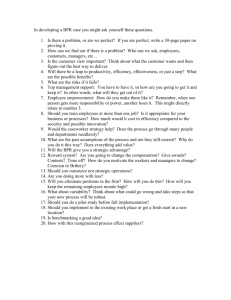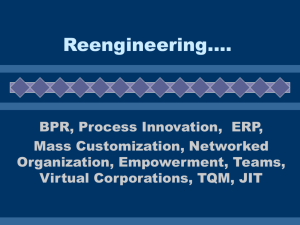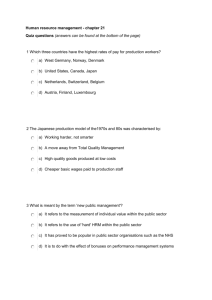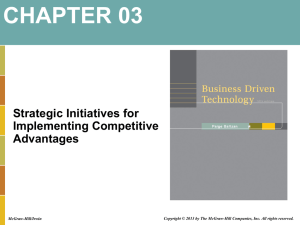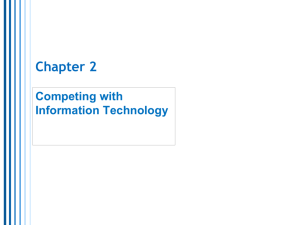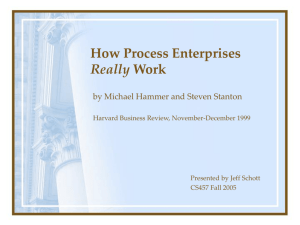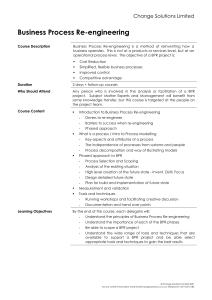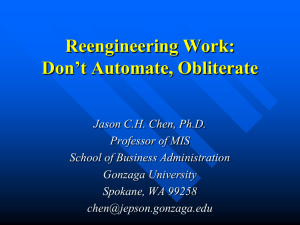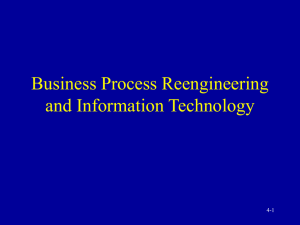1 Lecture 8. Enterprise Reengineering
advertisement
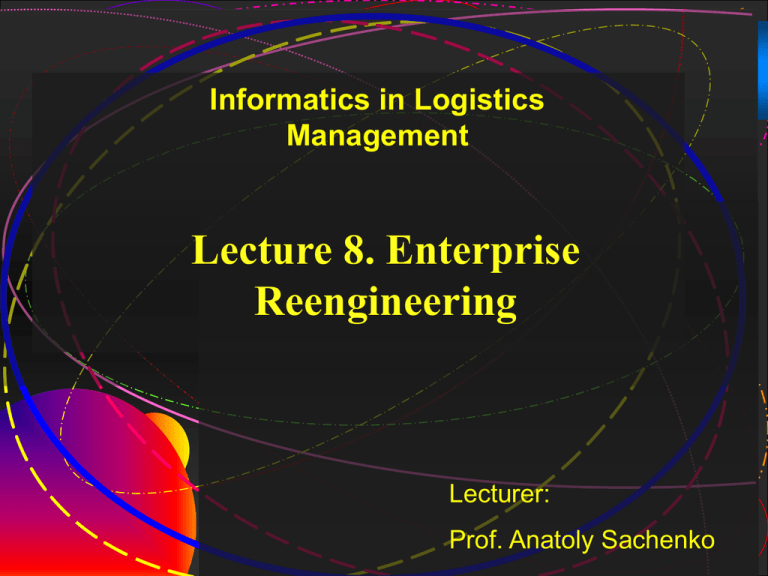
1 Informatics in Logistics Management Lecture 8. Enterprise Reengineering Lecturer: Prof. Anatoly Sachenko 2 Lecture overview Enterprise Engineering and Reengineering Definition The scope of Enterprise Reengineering Business Process Reengineering Some BPR Issues BPR Problems IT role in BPR Steps for BPR 3 Enterprise Engineering and Reengineering Enterprise reengineering is regarded as an approach within enterprise engineering Enterprise engineering is "an life-cycle oriented discipline for identification, design and implementation of enterprises and their continuous evolution" (Kosanke et al, 1999) Enterprises models are "essential components in enterprise engineering" (IFIP-IFAC taskforce, 1999) Enterprise engineering encompasses HW, SW communications protocols, info, and architectures, but also social and organizational issues that are relevant for enterprise modeling and improvement 4 Definition Enterprise reengineering focuses primarily on the operations activities, and how they should be modelled and designed The total transformation process can be decomposed into a large collection of concurrent processes executed by a set of operations entities that contribute to business objectives Each process consist of a group of operations activities that takes input, adds value to it and provides an output to internal or external customers 5 Definition Enterprise reengineering is essentially a matter of modeling and improving these activities: how they are grouped in operations entities and processes, how resources are dedicated to the operations entities, how resources are laid out physically to create information and material flows, how operations entities activities are structured in the organization, and, how processes are controlled. 6 The scope of Enterprise Reengineering The idea behind enterprise engineering is that enterprises may be engineered like any other complex systems The enterprise is a system that must be engineered, implemented, and integrated in a systematic way very similar to approaches developed for software engineering 7 The scope of Enterprise Reengineering Enterprise reengineering is an model-based approach that aims to improve operations performance in the overall direction determined by the operations strategy The main purpose of operations strategy is to make plans for how the enterprise can improve it’s competitiveness This encompasses numerous strategic decisions that range from human resources strategies to localization of new enterprises, and It’s directing the work in research fields such as operations management and enterprise engineering 8 The scope of Enterprise Reengineering However, since these are research fields that cover many design issues, the scope of enterprise reengineering, as defined in this thesis, is restricted to the modeling and reengineering of operations processes That is, how operations processes are logically and physically organized, and how they are controlled 9 The scope of Enterprise Reengineering 10 Business Process Reengineering Enterprise Re-Engineering / Business Process Re-Engineering (BPR) is a form of organizational improvement It aims to improve a business through restructuring of processes BPR is given force by the thinking that old ways of organizing work are no longer appropriate for a competitive business environment The ultimate aim of re-engineering processes to achieve better quality, service and innovativeness The radical restructuring entailed in BPR is risky and uncertain 11 Business Process Reengineering For hundreds of years, commercial activity has been based on the Adam Smith principle of Division of Labor Division of labor encourages specialization and thereby leads to improved productivity The classical enterprise also exhibits the concepts of: Hierarchical control: - the classical layers of management Mass production of largely uniform goods/services 12 Business Process Reengineering An organization based on these principles is successful in a stable market environment, characterized by growing demand for uniform goods/services In a changed market environment characterized by sever competition, globalization, more demanding customers, smaller profit margins etc, the classical organizational models are less and less appropriate BPR provides one alternative to the old methods of organizing business processes The goals of BPR can be started in expanded form as either cost objectives or service objectives 13 Hierarchical Design Pyramid 14 Cost Objectives Reducing stocks: New materials or Intermediate goods Economies of scale in procurement Reduced staff costs (administrative costs) Competitive pricing of goods/services 15 Service Objectives More reliable delivery system Stock availability Good after sales service Quick Response/adaptation to market changes Reduced product development lifecycle 16 The role of enterprise reengineering in operations strategy development 17 A strategic framework for enterprise reengineering 18 Qualities of BPR Several jobs are combined into one This implies a reversal of the Adam Smith principle of division of labor and function Workers make decisions, actual work and decision making are integrated Processes are reorganized so that tasks are done in the most sensible/logical order Checks and controls are reduced The checks and controls are reduced to the minimum acceptable level The checks and controls are also deferred(cont-d) 19 Qualities of BPR Reconciliation is minimized. A case manager is appointed to oversee the reengineering process. Hybrid processes that combine centralization and decentralization by use of communication technology are often adopted. Processes have multiple versions (polymorphic) – the process is re-designed to include capabilities to deal with custom orders. 20 Some BPR Issues Candidates for BPR: In theory, any business process can be subject to BPR; but in practice, certain processes can benefit more from BPR than others Such processes have the following qualities Dysfunction: The process is visibly out of order, it is problematic Dysfunction in a process occurs when the process is slow (frustratingly slow), occasional complaints, generates errors(cont-d) 21 Some BPR Issues Importance: Important processes that have a prominent place in the value chain They contribute directly to the delivery of goods and services to the end consumer. Feasible: From the managers stand point the BPR project is technically, economically and socially feasible/viable Processes that require high capital input, or enjoy limited management support are less feasible for BPR. 22 BPR Problems What causes BPR projects to fail?: Inadequate funding Insufficient management commitment/support Poor project leaders Inadequate feasibility evaluation Resistance to process change Failure to focus on most process re-design and dwelling on improving the existing process. Quitting too early or declaring victory too soon. 23 BPR Problems Re-engineering or Re-developing? Systems targeted for re-engineering have 2 qualities They are heavily/regularly used They are currently being maintained a lot Re-engineering usually has two main merits over re-developing. These are: Lower costs: re-engineering costs about ? of redeveloping Reduced risk: lower likelihood of making mistakes. 24 IT role in BPR IT enables processes to be re-engineered It supports the re-engineered process Leading edge technology products can be particularly useful in process innovation They can even lead the innovation process. IT also facilitates process integration. It has been argued that the most effective contribution of IT in business redesign is to enable an enterprise to do things that it was not doing before – extending the capabilities of the enterprise. 25 IT role in BPR BPR computer system: at a minimum it comprises of an ordered collection of HW/SW and data resources Computer systems are the basis for automated information system. Re-engineering computer systems means examining, rethinking and re-implementing such systems in a new form. The process is usually carried out on legacy options, re-implementing them in a more modern form. Re-engineering computer systems can be seen as a management response to the challenge of keeping old systems alive within a changing environment. 26 IT role in BPR Merits The useful life of a system is increased The business value of such a system also increases Future maintenance costs are reduced The morale of maintenance staff may improve; because they know they are working in a modern system i.e. the systems become more maintainable. 27 IT role in BPR Approaches to re-engineering computer systems: When a system is re-engineered any of the following changes may occur: It may be placed in a distributed platform. It will usually be re-documented The data may be migrated to a new database platform The code may be restricted The code may be written in a different language 28 Automated Program Restructuring When code is maintained over an extended period, its structure and hence its efficiency, deteriorate Indeed, the more a software product has been maintained, the more it costs to maintain it in future When the program is re-structured: irreconcilable code is detected and removed complex control structures are simplified program modularity is enhanced Use of software tools may not be fully effective. Manual rewriting of code may still be applied. 29 Automated Program Restructuring Automated program and Data Restructuring: When the existing data structures are restructured then even the programs that process the data have to be reviewed When data is restructured: The overall model may be re-organized into one database. Data in a relational model may be modified to suit the needs of a different relational DBMS. 30 The enterprise reengineering methodology 31 Steps for BPR Identify process for innovations Manage business Manage people and work Identify change levels ( technology etc) Develop process vision – what you want to process must fit with the strategic direction of the organization (IS) Understand existing processes – study current process and understand necessary changes Design and prototype new process/create design of new process(cont-d) 32 Steps for BPR When deciding whether to re-engineer or to redevelop you may consider such issues as: budget provisions or costs constraints current state of the old system; the old system may be so old and messy that it may not be susceptible to reengineering Time limitations: re-engineering is likely to be quicker than to redevelop(cont-d) 33 Steps for BPR Scope i.e. system scope; if the scope of the existing system is to be excluded substantially then it may be more practical to redesign and re-implement the system instead of re-engineering it. Perceived risk level; Risk arises from the combined effect of many factors If the perceived project risk is high then it might be safer to re-engineer the system than to redevelop it. 34 Steps for BPR Link between reengineering of computer systems and BPR: Computer systems are usually embodied within business processes/systems such as accounts receivable, production planning, marketing and distribution, human resources etc When such process/systems are reengineered, then the supporting technology infrastructure also needs to be reviewed(cont-d) 35 Steps for BPR The overall aim of reengineering a computer system should be to re-align it with the existing business goals The goals of a BPR project require an altered IT infrastructure then the existing infrastructure should be reengineered or re-developed (cont-d) 36 Steps for BPR The enterprise reengineering methodology supports manufacturing enterprises in efforts to improve operations performance. The objective is to achieve fit between operations capabilities and market requirements through a reengineering of operations processes. The methodology is model-based and applies an enterprise modelling architecture to represent different views of enterprise operations. Reengineering efforts are typically carried out when some problem makes it difficult for operations to achieve their performance objective (cont-d) 37 Steps for BPR The enterprise reengineering process includes: Mapping and evaluating the current operations strategy, i.e. the strategic decisions regarding operations (such as the implementation of a best practice method) and the affected decisions areas and performance objectives. Mapping the AS-IS operations model, and representing the enterprise graphically from a resource-, material-, info-, process- organization-, and control view (termed control model) should represents a synthesis of the other views and show a picture how operation processes are organized and controlled (cont-d) 38 Steps for BPR Analyzing the current operations model on operation capabilities (operations processes, control methods, layout etc,) and their ability to meet the demand situation Analyzing operations capabilities in an audit sheet in order to rate the performance in broad areas of strengths and weaknesses Based on this analysis, improvement areas are identified and problems to be solved are formulated(cont-d) 39 Steps for BPR Designing a revised operations strategy that targets the improvement areas identified in the mapping and analysis. Designing a TO-BE operations model that represents the new solution for operations. The design efforts can be supported by best practice methods such as flow manufacturing. Implementing the operations model. 40 References Bruce Caldwell "Missteps, Miscues: Business reengineering failures have cost corporations billions" InformationWEEK June 20, 1994, pp. 50-60. Elliot Chikofski and James H. Cross II "Reverse Engineering and Design Recovery: A Taxonomy" IEEE Software January 1990 7(1):13-17. Michael Hammer & James Champy Reengineering the Corporation: A manifesto for business revolution Harper Business, 1993. Stephanie King "How to Fail" NAPM Insights February 1995 pp. 50-52. Kosanke, K., Vernadat, F., Zelm, M. (1999) CIMOSA: enterprise engineering and integration. In Computers in industry 40, pp.83-97. 41 References Leatt, P., Baker, G.R., Halverson P.K and Aird C. Downsizing, Reengineering and Restructuring: LongTerm Implications for Economical Organisations // Strategic Management Journal, 2004, vol.13, No(4), pp. 578-599. Erlend Alfnes. Enterprise Reengineering. VDM Verlag, 2008. – 320 p. Vernadat, F.B. (1996) Enterprise Modelling and Integration: principles and applications. Chapman & Hall. IFIP–IFAC Task Force on Architectures for Enterprise Integration (1999) Generalised Enterprise Reference Architecture and Methodology, Version 1.6.3 (March 1999).

